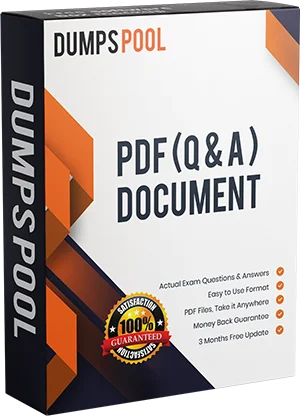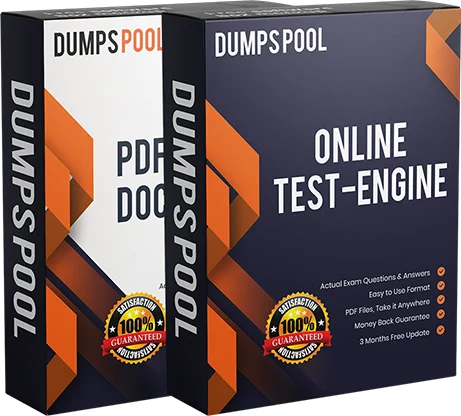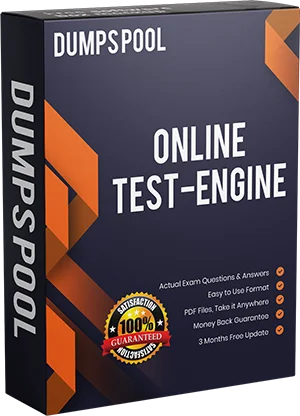PDF Only

$35.00 Free Updates Upto 90 Days
- SPLK-3003 Dumps PDF
- 85 Questions
- Updated On November 13, 2025
PDF + Test Engine

$55.00 Free Updates Upto 90 Days
- SPLK-3003 Question Answers
- 85 Questions
- Updated On November 13, 2025
Test Engine

$45.00 Free Updates Upto 90 Days
- SPLK-3003 Practice Questions
- 85 Questions
- Updated On November 13, 2025
How to pass Splunk SPLK-3003 exam with the help of dumps?
DumpsPool provides you the finest quality resources you’ve been looking for to no avail. So, it's due time you stop stressing and get ready for the exam. Our Online Test Engine provides you with the guidance you need to pass the certification exam. We guarantee top-grade results because we know we’ve covered each topic in a precise and understandable manner. Our expert team prepared the latest Splunk SPLK-3003 Dumps to satisfy your need for training. Plus, they are in two different formats: Dumps PDF and Online Test Engine.
How Do I Know Splunk SPLK-3003 Dumps are Worth it?
Did we mention our latest SPLK-3003 Dumps PDF is also available as Online Test Engine? And that’s just the point where things start to take root. Of all the amazing features you are offered here at DumpsPool, the money-back guarantee has to be the best one. Now that you know you don’t have to worry about the payments. Let us explore all other reasons you would want to buy from us. Other than affordable Real Exam Dumps, you are offered three-month free updates.
You can easily scroll through our large catalog of certification exams. And, pick any exam to start your training. That’s right, DumpsPool isn’t limited to just Splunk Exams. We trust our customers need the support of an authentic and reliable resource. So, we made sure there is never any outdated content in our study resources. Our expert team makes sure everything is up to the mark by keeping an eye on every single update. Our main concern and focus are that you understand the real exam format. So, you can pass the exam in an easier way!
IT Students Are Using our Splunk Core Certified Consultant Dumps Worldwide!
It is a well-established fact that certification exams can’t be conquered without some help from experts. The point of using Splunk Core Certified Consultant Practice Question Answers is exactly that. You are constantly surrounded by IT experts who’ve been through you are about to and know better. The 24/7 customer service of DumpsPool ensures you are in touch with these experts whenever needed. Our 100% success rate and validity around the world, make us the most trusted resource candidates use. The updated Dumps PDF helps you pass the exam on the first attempt. And, with the money-back guarantee, you feel safe buying from us. You can claim your return on not passing the exam.
How to Get SPLK-3003 Real Exam Dumps?
Getting access to the real exam dumps is as easy as pressing a button, literally! There are various resources available online, but the majority of them sell scams or copied content. So, if you are going to attempt the SPLK-3003 exam, you need to be sure you are buying the right kind of Dumps. All the Dumps PDF available on DumpsPool are as unique and the latest as they can be. Plus, our Practice Question Answers are tested and approved by professionals. Making it the top authentic resource available on the internet. Our expert has made sure the Online Test Engine is free from outdated & fake content, repeated questions, and false plus indefinite information, etc. We make every penny count, and you leave our platform fully satisfied!
Splunk SPLK-3003 Frequently Asked Questions
Question # 1
Which statement is true about sub searches?
A. Sub searches are faster than other types of searches.
B. Sub searches work best for joining two large result sets.
C. Sub searches run at the same time as their outer search.
D. Sub searches work best for small result sets.
Question # 2
A customer has implemented their own Role Based Access Control (RBAC) model to attempt to give the Security team different data access than the Operations team by creating two new Splunk roles – security and operations. In the srchIndexesAllowed setting of authorize.conf, they specified the network index under the security role and the operations index under the operations role. The new roles are set up to inherit the default user role. If a new user is created and assigned to the operations role only, which indexes will the user have access to search?
A. operations, network, _internal, _audit
B. operations
C. No Indexes
D. operations, network
Question # 3
A new single-site three indexer cluster is being stood up with replication_factor:2, search_factor:2. At which step would the Indexer Cluster be classed as ‘Indexing Ready’ and be able to ingest new data? Step 1: Install and configure Cluster Master (CM)/Master Node with base clustering stanza settings, restarting CM. Step 2: Configure a base app in etc/master-apps on the CM to enable a splunktcp input on port 9997 and deploy index creation configurations. Step 3: Install and configure Indexer 1 so that once restarted, it contacts the CM, download the latest config bundle. Step 4: Indexer 1 restarts and has successfully joined the cluster. Step 5: Install and configure Indexer 2 so that once restarted, it contacts the CM, downloads the latest config bundle Step 6: Indexer 2 restarts and has successfully joined the cluster. Step 7: Install and configure Indexer 3 so that once restarted, it contacts the CM, downloads the latest config bundle. Step 8: Indexer 3 restarts and has successfully joined the cluster.
A. Step 2
B. Step 4
C. Step 6
D. Step 8
Question # 4
A customer has a network device that transmits logs directly with UDP or TCP over SSL. Using PS best practices, which ingestion method should be used?
A. Open a TCP port with SSL on a heavy forwarder to parse and transmit the data to the indexing tier.
B. Open a UDP port on a universal forwarder to parse and transmit the data to the indexing tier.
C. Use a syslog server to aggregate the data to files and use a heavy forwarder to read and transmit the data to the indexing tier.
D. Use a syslog server to aggregate the data to files and use a universal forwarder to read and transmit the data to the indexing tier.
Question # 5
A customer has a search cluster (SHC) of six members split evenly between two data centers (DC). The customer is concerned with network connectivity between the two DCs due to frequent outages. Which of the following is true as it relates to SHC resiliency when a network outage occurs between the two DCs?
A. The SHC will function as expected as the SHC deployer will become the new captain until the network communication is restored.
B. The SHC will stop all scheduled search activity within the SHC.
C. The SHC will function as expected as the minimum required number of nodes for a SHC is 3.
D. The SHC will function as expected as the SHC captain will fall back to previous active captain in the remaining site.
Question # 6
When a bucket rolls from cold to frozen on a clustered indexer, which of the following scenarios occurs?
A. All replicated copies will be rolled to frozen; original copies will remain.
B. Replicated copies of the bucket will remain on all other indexers and the Cluster Mast (CM) assigns a new primary bucket.
C. The bucket rolls to frozen on all clustered indexers simultaneously.
D. Nothing. Replicated copies of the bucket will remain on all other indexers until a local retention rule causes it to roll.
Question # 7
In addition to the normal responsibilities of a search head cluster captain, which of the following is a default behavior?
A. The captain is not a cluster member and does not perform normal search activities.
B. The captain is a cluster member who performs normal search activities.
C. The captain is not a cluster member but does perform normal search activities.
D. The captain is a cluster member but does not perform normal search activities.
Question # 8
In a single indexer cluster, where should the Monitoring Console (MC) be installed?
A. Deployer sharing with master cluster.
B. License master that has 50 clients or more.
C. Cluster master node
D. Production Search Head
Question # 9
What is the default push mode for a search head cluster deployer app configuration bundle?
A. full
B. merge_to_default
C. default_only
D. local_only
Question # 10
Data can be onboarded using apps, Splunk Web, or the CLI. Which is the PS preferred method?
A. Create UDP input port 9997 on a UF.
B. Use the add data wizard in Splunk Web.
C. Use the inputs.conf file.
D. Use a scripted input to monitor a log file.
Question # 11
Which of the following server roles should be configured for a host which indexes its internal logs locally?
A. Cluster master
B. Indexer
C. Monitoring Console (MC)
D. Search head
Question # 12
Which of the following is the most efficient search?
A. index=www status=200 uri=/cart/checkout | append [search index = sales] | stats count, sum(revenue) as total_revenue by session_id | table total_revenue session_id
B. (index=www status=200 uri=/cart/checkout) OR (index=sales) | stats count, sum (revenue) as total_revenue by session_id | table total_revenue session_id
C. index=www | append [search index = sales] | stats count, sum(revenue) as total_revenue by session_id | table total_revenue session_id
D. (index=www) OR (index=sales) | search (index=www status=200 uri=/cart/checkout) OR (index=sales) | stats count, sum(revenue) as total_revenue by session_id | table total_revenue session_id
Question # 13
What is the primary driver behind implementing indexer clustering in a customer’s environment?
A. To improve resiliency as the search load increases.
B. To reduce indexing latency.
C. To scale out a Splunk environment to offer higher performance capability.
D. To provide higher availability for buckets of data.
Question # 14
A customer is using regex to whitelist access logs and secure logs from a web server, but only the access logs are being ingested. Which troubleshooting resource would provide insight into why the secure logs are not being ingested?
A. list monitor
B. oneshot
C. btprobe
D. tailingprocessor
Question # 15
A customer has 30 indexers in an indexer cluster configuration and two search heads. They are working on writing SPL search for a particular use-case, but are concerned that it takes too long to run for short time durations. How can the Search Job Inspector capabilities be used to help validate and understand the customer concerns?
A. Search Job Inspector provides statistics to show how much time and the number of events each indexer has processed.
B. Search Job Inspector provides a Search Health Check capability that provides an optimized SPL query the customer should try instead.
C. Search Job Inspector cannot be used to help troubleshoot the slow performing search; customer should review index=_introspection instead.
D. The customer is using the transaction SPL search command, which is known to be slow.
Question # 16
A customer is migrating their existing Splunk Indexer from an old set of hardware to a new set of indexers. What is the earliest method to migrate the system?
A. 1. Add new indexers to the cluster as peers, in the same site (if needed). 2.Ensure new indexers receive common configuration. 3.Decommission old indexers (one at a time) to allow time for CM to fix/migrate buckets to
new hardware. 4.Remove all the old indexers from the CM’s list.
B. 1. Add new indexers to the cluster as peers, to a new site. 2.Ensure new indexers receive common configuration from the CM. 3.Decommission old indexers (one at a time) to allow time for CM to fix/migrate buckets to new hardware. 4.Remove all the old indexers from the CM’s list.
C. 1. Add new indexers to the cluster as peers, in the same site. 2.Update the replication factor by +1 to Instruct the cluster to start replicating to new peers. 3.Allow time for CM to fix/migrate buckets to new hardware. 4.Remove all the old indexers from the CM’s list.
D. 1. Add new indexers to the cluster as new site. 2.Update cluster master (CM) server.conf to include the new available site. 3.Allow time for CM to fix/migrate buckets to new hardware. 4.Remove the old indexers from the CM’s list.
Question # 17
A new search head cluster is being implemented. Which is the correct command to initialize the deployer node without restarting the search head cluster peers?
A. $SPLUNK_HOME/bin/splunk apply shcluster-bundle
B. $SPLUNK_HOME/bin/splunk apply cluster-bundle
C. $SPLUNK_HOME/bin/splunk apply shcluster-bundle –action stage
D. $SPLUNK_HOME/bin/splunk apply cluster-bundle –action stage
Leave a comment
Your email address will not be published. Required fields are marked *